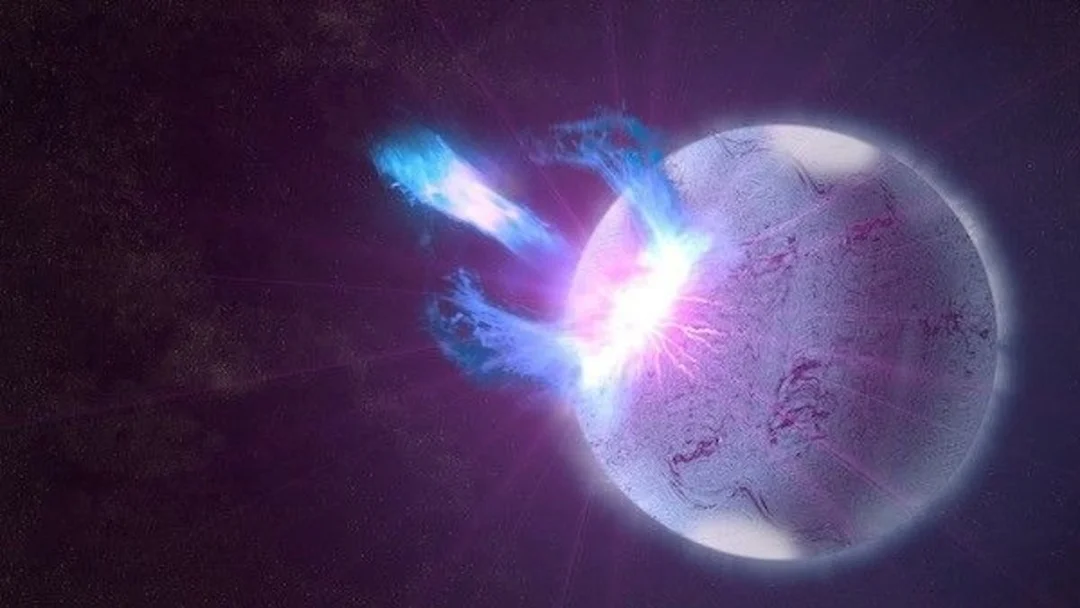
Magnetar Flares: Cosmic Forges of Gold and Heavy Elements Reveal Universe’s Secrets
For decades, the origin of the universe's heavy elements, like gold and platinum, has remained a cosmic mystery. Now, a stunning breakthrough suggests that powerful magnetar flares, emanating from ultra-magnetized stars, may be a key source. These flares, releasing energy equivalent to a million years of the Sun's output, could account for up to 10% of the galaxy's heavy element supply, challenging previous assumptions that neutron star collisions were the sole origin.
The findings, published in *The Astrophysical Journal Letters*, link a 2004 space signal to a magnetar flare that forged massive amounts of heavy elements. This solves a 20-year mystery and opens up new avenues for understanding these stellar factories. 
Magnetars are neutron stars with magnetic fields trillions of times stronger than Earth's. Scientists at the Flatiron Institute’s Center for Computational Astrophysics determined that a second, weaker signal detected 10 minutes after the initial 2004 flare was evidence of heavy element formation.
"This is really just the second time we’ve ever directly seen proof of where these elements form, the first being neutron star mergers,” says Brian Metzger, a senior research scientist at the CCA and a professor at Columbia University. “It’s a substantial leap in our understanding of heavy elements production.”
While lighter elements like hydrogen and helium were formed in the Big Bang, heavier elements are forged in stars. The production of elements heavier than iron requires extreme conditions, leading astronomers to initially focus on supernovas and neutron star mergers. The 2017 observation of two colliding neutron stars confirmed this theory, but astronomers realized these events alone couldn’t account for all the heavy elements we see.
Enter magnetars. In 2024, Metzger and his colleagues calculated that giant flares could eject material from a magnetar’s crust into space, where r-process elements could form.
According to Anirudh Patel, a doctoral candidate at Columbia University, “It’s pretty incredible to think that some of the heavy elements all around us, like the precious metals in our phones and computers, are produced in these crazy extreme environments.” These flares create unstable, heavy radioactive nuclei, which then decay into stable elements like gold.
Reinterpreting a Forgotten Signal
The team found that the glow from the radioactive decays would be visible as a burst of gamma rays. Discussing this finding with gamma-ray astronomers revealed that such a signal had been observed decades earlier but remained unexplained. The 2004 gamma-ray burst from magnetar SGR 1806–20 aligned perfectly with the model of heavy element production from magnetar flares.
Calculations based on the 2004 event estimate that the flare produced 2 million billion billion kilograms of heavy elements. Researchers believe that magnetar flares might occur early in galactic history, potentially resolving inconsistencies in the abundance of heavy elements observed in young galaxies. LSU scientists, including Eric Burns and Aaron Trigg, have also contributed to this understanding by studying archival data of magnetar giant flares.
To further investigate this phenomenon, telescopes like NASA's Compton Spectrometer and Imager mission, launching in 2027, will be crucial for capturing more of these signals.
These findings suggest that the hunt for the origins of precious metals is far from over. Does the discovery of magnetar flares as element forges change our understanding of where to look for life beyond Earth? Leave your thoughts and theories in the comments below!